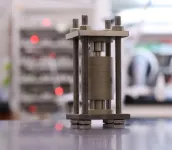(Press-News.org) Scientists at the National Eye Institute (NEI) have developed a promising gene therapy strategy for a rare disease that causes severe vision loss in childhood. A form of Leber congenital amaurosis, the disease is caused by autosomal-dominant mutations in the CRX gene, which are challenging to treat with gene therapy. The scientists tested their approach using lab-made retinal tissues built from patient cells, called retinal organoids. This approach, which involved adding copies of the normal gene under its native control mechanism, partially restored CRX function. The study report appears today in Stem Cell Reports. NEI is part of the National Institutes of Health.
"Our treatment approach, which adds more copies of the normal gene, could potentially treat autosomal-dominant LCA caused by a variety of mutations," said Anand Swaroop, Ph.D., chief of the NEI Neurobiology, Neurodegeneration and Repair Laboratory and senior author of the report.
The U.S. Food and Drug Administration approved Luxturna in 2017 for the treatment of LCA patients with mutations in a gene called RPE65. Although hailed as a major advance in gene therapy, Luxturna is ineffective against other forms of LCA, including those caused by autosomal-dominant mutations in CRX.
The CRX gene encodes a protein (also called CRX) that binds to DNA and instructs the retina's photoreceptors to make light-sensitive pigments called opsins. Without functional CRX protein, photoreceptors lose their ability to detect light and eventually die.
Disorders like autosomal-dominant LCA are tricky to treat with gene therapy, because adding more of the normal gene does not always restore function. People with autosomal-dominant mutations still have one normal copy of the gene, but the mutant version of the protein interferes with the normal protein. Sometimes, instead of restoring normal function, simply adding more of the normal protein can enhance the disease in unpredictable ways.
To explore how gene augmentation - adding copies of the normal gene - would affect autosomal-dominant LCA, Swaroop's team, developed retinal organoids from two volunteers with LCA and from their unaffected family members. Led by Kamil Kruczek, Ph.D., a postdoctoral fellow in Swaroop's lab, they built the complex retina-like tissues in several stages, starting with skin cells, inducing the production of mature photoreceptors and other retinal cells with the genetic profile of each volunteer. As expected, patient organoids made far less light-sensing opsin than the organoids made from unaffected family members.
To carefully control how much CRX gene would be expressed by the recipient photoreceptors, the team re-engineered the CRX promoter so it could be delivered with the CRX gene as part of the gene therapy. A promoter is a neighboring sequence of DNA that controls when and how genes are expressed. The researchers packed the gene and their engineered promoter inside a virus that shuttled them into the organoid photoreceptors.
The team's gene augmentation strategy restored some CRX protein function for organoids from both patients, driving expression of opsins in both types of photoreceptors: rods and cones.
"The fact that this strategy worked for both CRX mutations was pretty exciting," said Swaroop. "Gene augmentation may be a viable therapy for LCA caused by other autosomal-dominant mutations."
"This proof-of-concept gene therapy study is the first step toward a potential treatment for a rare form of LCA," said Brian Brooks, M.D., NEI clinical director and co-author on the study. "It's a great example of bench-to-bedside science, when researchers in basic and clinical science collaborate."
INFORMATION:
The current study was funded through the intramural programs of the NEI and the National Institute of Allergy and Infectious Diseases, both part of NIH. Patient samples were collected at the NIH Clinical Center, clinical trial number NCT01432847.
NEI has protected intellectual property around this technology which is available for licensing and or co-development. Details can be found on the NIH OTT Licensing website: Gene Therapy for Treatment of CRX-Autosomal Dominant Retinopathies | Office of Technology Transfer, NIH or by contacting NEI Office of Translational Research mala.dutta@nih.gov
Additional authors include: Zepeng Qu, James Gentry, Benjamin Fadl, Linn Gieser, Suja Hiriyanna, Zacahry Batz, Mugdha Samant, Ananya Samanta, Colin Chu, Laura Campello, and Zhijian Wu.
Reference: Kruczek K. Qu Z, Gentry J, Fadl BR, Gieser L, Hiriyanna S, Batz Z, Samant M, Samanta A, Chu CJ, Campello L, Brooks BP, Wu Z, and Swaroop A. "Gene therapy of dominant CRX-Leber congenital amaurosis using patient stem cell-derived retinal organoids." Stem Cell Reports, January 28, 2020.
NEI leads the federal government's research on the visual system and eye diseases. NEI supports basic and clinical science programs to develop sight-saving treatments and address special needs of people with vision loss. For more information, visit https://www.nei.nih.gov.
About the National Institutes of Health (NIH): NIH, the nation's medical research agency, includes 27 Institutes and Centers and is a component of the U.S. Department of Health and Human Services. NIH is the primary federal agency conducting and supporting basic, clinical, and translational medical research, and is investigating the causes, treatments, and cures for both common and rare diseases. For more information about NIH and its programs, visit https://www.nih.gov/.
NIH...Turning Discovery Into Health®
In early October 2019, when an unknown caller rang EPFL professor Johan Gaume's cell phone, he could hardly have imagined that he was about to confront one of the greatest mysteries in Soviet history. At the other end of the line, a journalist from The New York Times asked for his expert insight into a tragedy that had occurred 60 years earlier in Russia's northern Ural Mountains - one that has since come to be known as the Dyatlov Pass Incident. Gaume, head of EPFL's Snow and Avalanche Simulation Laboratory (SLAB) and visiting fellow at the WSL Institute for Snow and Avalanche Research SLF, had never heard ...
Researchers at the University of Basel and Ruhr University Bochum have developed a source of single photons that can produce billions of these quantum particles per second. With its record-breaking efficiency, the photon source represents a new and powerful building-block for quantum technologies.
Quantum cryptography promises absolutely secure communications. A key component here are strings of single photons. Information can be stored in the quantum states of these light particles and transmitted over long distances. In the future, remote quantum processors will communicate with each other via single photons. And perhaps the processor itself will use photons as quantum bits for computing.
A basic prerequisite for such applications, however, is an efficient source ...
Using X-ray tomography, a research team has observed the internal evolution of the materials inside solid-state lithium batteries as they were charged and discharged. Detailed three-dimensional information from the research could help improve the reliability and performance of the batteries, which use solid materials to replace the flammable liquid electrolytes in existing lithium-ion batteries.
The operando synchrotron X-ray computed microtomography imaging revealed how the dynamic changes of electrode materials at lithium/solid-electrolyte interfaces determine the behavior of solid-state batteries. The researchers found that battery operation caused voids to form ...
Science is society's best method for understanding the world, yet many people in the field are unhappy with the way it works. Rules and procedures meant to promote innovative research can have perverse side-effects that harm both science and scientists. One of these - the 'priority rule' - rewards scientists who make discoveries with prestige, prizes and better career opportunities, depriving the runners-up of similar perks. Researchers at University of Technology Eindhoven (TU/e) and the Arizona State University in the US have developed a new model to better understand this rule, and see if current reforms to improve the system actually make sense. Their study was published in Nature Human Behaviour.
"Over the past decade, there have been growing concerns that something ...
What The Study Did: This study finds that being a health care worker isn't associated with poorer outcomes among patients hospitalized with COVID-19.
Authors: Nauzer Forbes, M.D., M.Sc., of the University of Calgary in Canada, is the corresponding author.
To access the embargoed study: Visit our For The Media website at this link https://media.jamanetwork.com/
(doi:10.1001/jamanetworkopen.2020.35699)
Editor's Note: The article includes conflict of interest disclosures. Please see the article for additional information, ...
Risky behaviors such as smoking, alcohol and drug use, speeding, or frequently changing sexual partners result in enormous health and economic consequences and lead to associated costs of an estimated 600 billion dollars a year in the US alone. In order to define measures that could reduce these costs, a better understanding of the basis and mechanisms of risk-taking is needed.
Functional and anatomical differences
UZH neuro-economists Goekhan Aydogan, Todd Hare and Christian Ruff, together with an international research team looked at the genetic characteristics that correlate with risk-taking behavior. Using a representative sample of 25,000 people, the researchers examined the relationship ...
BOSTON - A nationwide panel of experts has developed the first mammography guidelines for older survivors of breast cancer, providing a framework for discussions between survivors and their physicians on the pros and cons of screening in survivors' later years.
The guidelines, published online today in a paper in JAMA Oncology, recommend discontinuing routine mammograms for survivors with a life expectancy under five years; considering stopping screening for those with a 5-10-year life expectancy; and continuing mammography for those whose life expectancy is greater than 10 years. The guidelines will be complemented by printed materials to help survivors gauge their risk of cancer recurring in the breast and weigh the potential benefits and drawbacks of mammography with ...
Science is society's best method for understanding the world. Yet many scientists are unhappy with the way it works, and there are growing concerns that there is something "broken" in current scientific practice. Many of the rules and procedures that are meant to promote innovative research are little more than historical precedents with little reason to suppose they encourage efficient or reliable discoveries. Worse, they can have perverse side-effects that harm both science and scientists. A well-known example is the general preference for positive over negative results, which creates a "publication bias" that gives the false ...
CLEVELAND - Cleveland Clinic researchers have described for the first time how Zika virus (ZIKV) causes one of the most common birth defects associated with prenatal infection, called brain calcification, according to new study findings published in Nature Microbiology.
The findings may reveal novel strategies to prevent prenatal ZIKV brain calcification and offer important insights into how calcifications form in other congenital infections.
"Brain calcification has been linked to several developmental defects in infants, including motor disorders, cognitive disability, eye abnormalities, hearing deficits and seizures, so it's important to better understand the mechanisms of how they develop," said Jae Jung, ...
Advances in DNA sequencing have uncovered a rare syndrome which is caused by variations in the gene SATB1.
The study, co-authored by academics from Oxford Brookes University (UK), University of Lausanne (Switzerland), Radboud University (The Netherlands), University of Oxford (UK), University of Manchester (UK) and led by Max Planck Institute for Psycholinguistics (The Netherlands), discovered three classes of mutations within the gene SATB1, resulting in three variations of a neurodevelopmental disorder with varying symptoms ranging from epilepsy to muscle tone abnormalities.
Recognition of disorder will increase understanding and diagnosis
An international team of geneticists and clinicians from 12 countries identified 42 patients with mutations in the gene ...






